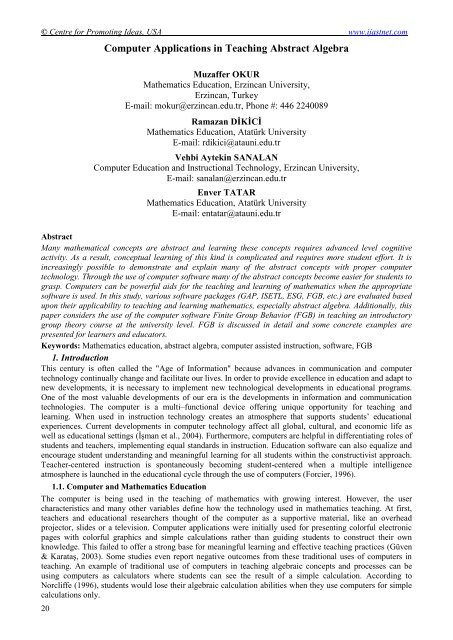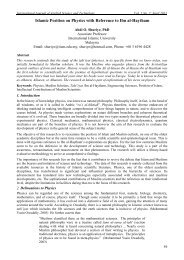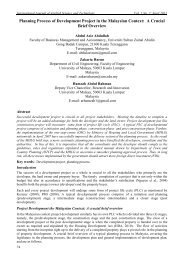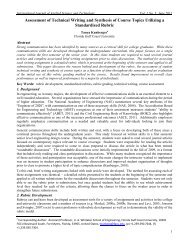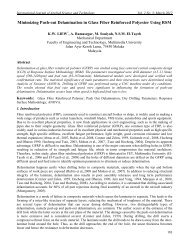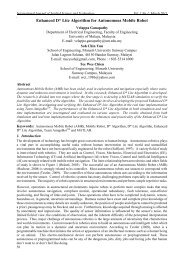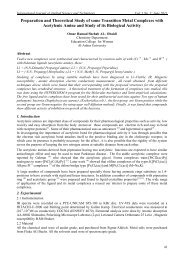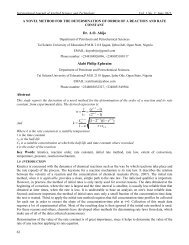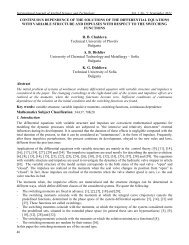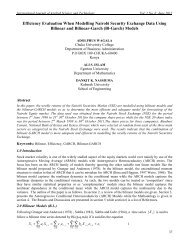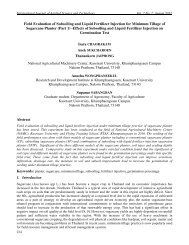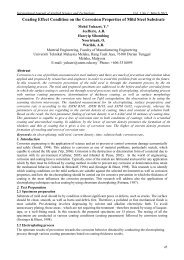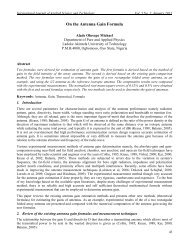Computer Applications in Teaching Abstract Algebra - International ...
Computer Applications in Teaching Abstract Algebra - International ...
Computer Applications in Teaching Abstract Algebra - International ...
Create successful ePaper yourself
Turn your PDF publications into a flip-book with our unique Google optimized e-Paper software.
© Centre for Promot<strong>in</strong>g Ideas, USA www.ijastnet.com<br />
<strong>Computer</strong> <strong>Applications</strong> <strong>in</strong> Teach<strong>in</strong>g <strong>Abstract</strong> <strong>Algebra</strong><br />
Muzaffer OKUR<br />
Mathematics Education, Erz<strong>in</strong>can University,<br />
Erz<strong>in</strong>can, Turkey<br />
E-mail: mokur@erz<strong>in</strong>can.edu.tr, Phone #: 446 2240089<br />
Ramazan DİKİCİ<br />
Mathematics Education, Atatürk University<br />
E-mail: rdikici@atauni.edu.tr<br />
Vehbi Aytek<strong>in</strong> SANALAN<br />
<strong>Computer</strong> Education and Instructional Technology, Erz<strong>in</strong>can University,<br />
E-mail: sanalan@erz<strong>in</strong>can.edu.tr<br />
Enver TATAR<br />
Mathematics Education, Atatürk University<br />
E-mail: entatar@atauni.edu.tr<br />
<strong>Abstract</strong><br />
Many mathematical concepts are abstract and learn<strong>in</strong>g these concepts requires advanced level cognitive<br />
activity. As a result, conceptual learn<strong>in</strong>g of this k<strong>in</strong>d is complicated and requires more student effort. It is<br />
<strong>in</strong>creas<strong>in</strong>gly possible to demonstrate and expla<strong>in</strong> many of the abstract concepts with proper computer<br />
technology. Through the use of computer software many of the abstract concepts become easier for students to<br />
grasp. <strong>Computer</strong>s can be powerful aids for the teach<strong>in</strong>g and learn<strong>in</strong>g of mathematics when the appropriate<br />
software is used. In this study, various software packages (GAP, ISETL, ESG, FGB, etc.) are evaluated based<br />
upon their applicability to teach<strong>in</strong>g and learn<strong>in</strong>g mathematics, especially abstract algebra. Additionally, this<br />
paper considers the use of the computer software F<strong>in</strong>ite Group Behavior (FGB) <strong>in</strong> teach<strong>in</strong>g an <strong>in</strong>troductory<br />
group theory course at the university level. FGB is discussed <strong>in</strong> detail and some concrete examples are<br />
presented for learners and educators.<br />
Keywords: Mathematics education, abstract algebra, computer assisted <strong>in</strong>struction, software, FGB<br />
1. Introduction<br />
This century is often called the "Age of Information" because advances <strong>in</strong> communication and computer<br />
technology cont<strong>in</strong>ually change and facilitate our lives. In order to provide excellence <strong>in</strong> education and adapt to<br />
new developments, it is necessary to implement new technological developments <strong>in</strong> educational programs.<br />
One of the most valuable developments of our era is the developments <strong>in</strong> <strong>in</strong>formation and communication<br />
technologies. The computer is a multi–functional device offer<strong>in</strong>g unique opportunity for teach<strong>in</strong>g and<br />
learn<strong>in</strong>g. When used <strong>in</strong> <strong>in</strong>struction technology creates an atmosphere that supports students’ educational<br />
experiences. Current developments <strong>in</strong> computer technology affect all global, cultural, and economic life as<br />
well as educational sett<strong>in</strong>gs (İşman et al., 2004). Furthermore, computers are helpful <strong>in</strong> differentiat<strong>in</strong>g roles of<br />
students and teachers, implement<strong>in</strong>g equal standards <strong>in</strong> <strong>in</strong>struction. Education software can also equalize and<br />
encourage student understand<strong>in</strong>g and mean<strong>in</strong>gful learn<strong>in</strong>g for all students with<strong>in</strong> the constructivist approach.<br />
Teacher-centered <strong>in</strong>struction is spontaneously becom<strong>in</strong>g student-centered when a multiple <strong>in</strong>telligence<br />
atmosphere is launched <strong>in</strong> the educational cycle through the use of computers (Forcier, 1996).<br />
1.1. <strong>Computer</strong> and Mathematics Education<br />
The computer is be<strong>in</strong>g used <strong>in</strong> the teach<strong>in</strong>g of mathematics with grow<strong>in</strong>g <strong>in</strong>terest. However, the user<br />
characteristics and many other variables def<strong>in</strong>e how the technology used <strong>in</strong> mathematics teach<strong>in</strong>g. At first,<br />
teachers and educational researchers thought of the computer as a supportive material, like an overhead<br />
projector, slides or a television. <strong>Computer</strong> applications were <strong>in</strong>itially used for present<strong>in</strong>g colorful electronic<br />
pages with colorful graphics and simple calculations rather than guid<strong>in</strong>g students to construct their own<br />
knowledge. This failed to offer a strong base for mean<strong>in</strong>gful learn<strong>in</strong>g and effective teach<strong>in</strong>g practices (Güven<br />
& Karataş, 2003). Some studies even report negative outcomes from these traditional uses of computers <strong>in</strong><br />
teach<strong>in</strong>g. An example of traditional use of computers <strong>in</strong> teach<strong>in</strong>g algebraic concepts and processes can be<br />
us<strong>in</strong>g computers as calculators where students can see the result of a simple calculation. Accord<strong>in</strong>g to<br />
Norcliffe (1996), students would lose their algebraic calculation abilities when they use computers for simple<br />
calculations only.<br />
20
<strong>International</strong> Journal of Applied Science and Technology Vol. 1 No.1; March 2011<br />
Mackie (2002) expressed that the students may reach a po<strong>in</strong>t where they lack the understand<strong>in</strong>g of what they<br />
are do<strong>in</strong>g, when they merely type some necessary keys to process problems <strong>in</strong> a computer software program.<br />
Generally, the understand<strong>in</strong>g of certa<strong>in</strong> abstract mathematical concepts has always been a struggle. Because<br />
the structure of mathematics offers someth<strong>in</strong>g abstract, learn<strong>in</strong>g abstract concepts can be difficult for many<br />
students. However, this difficulty can be overcome or reduced by us<strong>in</strong>g concrete tools provided by software<br />
(Baki, 2002). Technological tools can be used <strong>in</strong> develop<strong>in</strong>g mathematical th<strong>in</strong>k<strong>in</strong>g, problem solv<strong>in</strong>g and<br />
creativity to build student concentration skills. These software programs discourage rote learn<strong>in</strong>g, and prevent<br />
students work<strong>in</strong>g on exhaust<strong>in</strong>g rout<strong>in</strong>es. In conjunction with algebra teach<strong>in</strong>g software, the effective use of<br />
<strong>in</strong>formation process<strong>in</strong>g technology <strong>in</strong> the teach<strong>in</strong>g of school mathematics is one of the topics primarily<br />
discussed among researchers. Adopt<strong>in</strong>g new technologies <strong>in</strong> teach<strong>in</strong>g mathematics can <strong>in</strong>fluence the<br />
development of educational policy, strategy, and structure (Ersoy, 2003).<br />
The high-tech <strong>in</strong>dustries of the new century have made abstract th<strong>in</strong>k<strong>in</strong>g and creative abstract abilities<br />
prerequisites for global economic competitiveness. Students can only ga<strong>in</strong> the abilities of abstract th<strong>in</strong>k<strong>in</strong>g<br />
once they establish the logical foundations of mathematics. The development of <strong>in</strong>formation process<strong>in</strong>g tools<br />
<strong>in</strong> mathematics learn<strong>in</strong>g can help students ga<strong>in</strong> problem solv<strong>in</strong>g and critical th<strong>in</strong>k<strong>in</strong>g skills. In this process the<br />
social constructivist approach should be used <strong>in</strong> teach<strong>in</strong>g to form skills such as exploration, analysis and<br />
algorithms of the logical relations beh<strong>in</strong>d the concepts (Hacısalihoglu et al., 2003). A vast body of literature<br />
exists report<strong>in</strong>g the effectiveness of computer-assisted <strong>in</strong>struction. These studies have shown that student<br />
achievement is much higher <strong>in</strong> classrooms where computers are used than <strong>in</strong> those without, and that us<strong>in</strong>g this<br />
approach, the students learn new concepts more effectively (Krishnamani & Kimm<strong>in</strong>s, 2001; Ra<strong>in</strong>bolt, 2002;<br />
Van & Dempsey, 2002). In addition, some researchers report that computer assisted <strong>in</strong>struction led to the<br />
development of upper level th<strong>in</strong>k<strong>in</strong>g skills and that the students learn conceptualiz<strong>in</strong>g rather than memoriz<strong>in</strong>g<br />
(Renshaw & Taylor, 2000; Ubuz, 2002).Develop<strong>in</strong>g from knowledge theory based on the constructivist<br />
philosophy, the use of the <strong>in</strong>formation process<strong>in</strong>g may lead to a more fertile and functional teach<strong>in</strong>g<br />
environment.<br />
In such an environment, the student can analyze complicated research problems, th<strong>in</strong>k about possible<br />
solutions, form hypotheses, and make generalizations. The student can draft his own mathematical works<br />
us<strong>in</strong>g the software. The software serves as a tool for the student to explore the <strong>in</strong>formation, concepts and facts<br />
<strong>in</strong> a work<strong>in</strong>g scenario prepared by the teacher. The student can participate <strong>in</strong> the activity us<strong>in</strong>g all the means to<br />
control his own learn<strong>in</strong>g. Derive and Mathematica are two software programs offer<strong>in</strong>g such learn<strong>in</strong>g<br />
facilities. Most software packages available <strong>in</strong> the market require very little programm<strong>in</strong>g skills. For example:<br />
Excel is a software program that can be used <strong>in</strong> place of pen, paper and calculator. The conversion table and<br />
graphics are generated by writ<strong>in</strong>g the necessary formula to the electronic table (Baki, 2001). Today there are<br />
many computer software programs used for teach<strong>in</strong>g and learn<strong>in</strong>g of mathematics (Cannon & Playoust, 1997;<br />
Krishnamani & Kimm<strong>in</strong>s, 2001; Baki, 2001; Ra<strong>in</strong>bolt, 2002; Çınar & Ardahan, 2003; Bardzell & Shannon,<br />
2004; Gülcü, 2004). The computer algebra systems such as, Derive, Mathematica, Magma and<br />
Maple have brought some <strong>in</strong>novations <strong>in</strong> advanced calculations, differential equations and other applied<br />
fields (Kulich, 2000).<br />
1.2. Us<strong>in</strong>g <strong>Computer</strong> <strong>Algebra</strong> Systems <strong>in</strong> Teach<strong>in</strong>g <strong>Abstract</strong> <strong>Algebra</strong><br />
Today the number of studies related to the teach<strong>in</strong>g of mathematics at all levels is <strong>in</strong>creas<strong>in</strong>g considerably.<br />
However, research related to the teach<strong>in</strong>g of mathematics at the university level is still rarely reported. Most<br />
of the experimental studies are about analysis, l<strong>in</strong>ear algebra and discrete mathematics (Hazzan, 1999). There<br />
are, however, a number of new research efforts <strong>in</strong>to the teach<strong>in</strong>g and learn<strong>in</strong>g of abstract algebra. <strong>Abstract</strong><br />
algebra is widely used <strong>in</strong> computer sciences, physics and chemistry. In addition it provides the foundation for<br />
the study of advanced mathematics. Questions that researchers have posed have <strong>in</strong>cluded: “can all the students<br />
learn the concepts more mean<strong>in</strong>gfully” and “what is the best method for teach<strong>in</strong>g?”. These questions led<br />
algebra educators to do more research on teach<strong>in</strong>g abstract algebra (Krishnamani & Kimm<strong>in</strong>s, 2001).<br />
One of the most significant challenges <strong>in</strong> teach<strong>in</strong>g and learn<strong>in</strong>g math is how to handle abstract concepts.<br />
<strong>Algebra</strong> plays an important role not only <strong>in</strong> mak<strong>in</strong>g the mean<strong>in</strong>g loaded by the notations but also <strong>in</strong> gett<strong>in</strong>g the<br />
results easily right after apply<strong>in</strong>g a mathematical operation and <strong>in</strong> generalization of logical arguments<br />
(Hacısalihoglu et al., 2003). Current studies on teach<strong>in</strong>g and learn<strong>in</strong>g abstract algebra can roughly be divided<br />
<strong>in</strong>to two groups: the first group considers the methods of teach<strong>in</strong>g abstract algebra while those <strong>in</strong> the second<br />
group study the development of conceptual comprehension and teach<strong>in</strong>g abstract algebra (Hazzan, 1999).<br />
Many problems are identified <strong>in</strong> the teach<strong>in</strong>g and learn<strong>in</strong>g of abstract algebra <strong>in</strong> the literature (Almeida, 1999;<br />
Hazzan & Zazkis, 2005). The researchers have also come to the conclusion that students' mistakes do not<br />
arise only from the complexity of the subject but also from weaknesses <strong>in</strong> the students' mathematical<br />
foundations.<br />
21
© Centre for Promot<strong>in</strong>g Ideas, USA www.ijastnet.com<br />
The concepts such as group theory <strong>in</strong> an <strong>in</strong>troduction to abstract algebra courses are particularly difficult for<br />
the students to learn and to ma<strong>in</strong>ta<strong>in</strong> positive attitudes toward (Campbell & Zazkis, 2002). It is possible to<br />
present most of these concepts us<strong>in</strong>g computer technology and to make them available for students for further<br />
learn<strong>in</strong>g. By us<strong>in</strong>g this approach most abstract concepts can be concretized and they become easier for<br />
students to grasp (Baki, 2002). Today, there are many software programs used <strong>in</strong> the teach<strong>in</strong>g and learn<strong>in</strong>g of<br />
abstract algebra. One of the programs is Magma <strong>Computer</strong> software (Qu<strong>in</strong>lan, 2007). Magma has a<br />
program language directly constructed on basic algebra notations and mean<strong>in</strong>g. In addition, Magma is<br />
suitable for study<strong>in</strong>g algebra <strong>in</strong>dividually unlike Maple and Mathematica (Kulich, 2000). It has been<br />
developed by a team of computer-algebra researchers supported by the Australian Research Union at the<br />
University of Sydney. This team also developed Cayley software to teach the group theory <strong>in</strong> the related<br />
areas of the theory between 1975 and 1985.<br />
The start<strong>in</strong>g po<strong>in</strong>t for the design of Magma was Cayley. While Cayley covers a limited area of algebra<br />
Magma covered the general algebra system. Magma is one of the computer software packages that can be<br />
used especially for algebra, number theory and geometry. Some well-known categories that Magma can be<br />
used to teach are f<strong>in</strong>ite groups, semi groups, r<strong>in</strong>gs, fields and geometric structures. In addition, the program<br />
has been used for advanced computer algebra courses, <strong>in</strong>troductions to group theory courses and the teach<strong>in</strong>g<br />
of vector spaces (Cannon & Playoust, 1997). Two other of the most common programs used <strong>in</strong> abstract<br />
algebra are Matlab and Maple (Qu<strong>in</strong>lan, 2007). Maple computer algebra system was orig<strong>in</strong>ally<br />
designed at Waterloo University <strong>in</strong> Canada. Charlwood (2002), studied teach<strong>in</strong>g symmetric and matrix groups<br />
<strong>in</strong> an <strong>in</strong>troductory abstract algebra course and <strong>in</strong>dicated that the teach<strong>in</strong>g approach enriched by Maple<br />
computer work<strong>in</strong>g pages contributed to the development of proof<strong>in</strong>g abilities <strong>in</strong> students.<br />
Mackiw (2002) stated that Matlab is useful for def<strong>in</strong><strong>in</strong>g the group relations, calculat<strong>in</strong>g the order of<br />
elements and show<strong>in</strong>g the elements of the sub-groups similar to Maple. He also expressed that by us<strong>in</strong>g<br />
these programs students have a chance to exam<strong>in</strong>e the non-commutative group types which they rarely meet.<br />
Both Matlab and Maple can be used <strong>in</strong> groups, r<strong>in</strong>gs and f<strong>in</strong>ite fields <strong>in</strong> teach<strong>in</strong>g abstract algebra and<br />
many other related areas such as cryptograph, cod<strong>in</strong>g theory and Polya count<strong>in</strong>g theory Klima et al., 2000;<br />
2007). Other computer software such as ESG, FGB, GAP, ISETL have been developed only for teach<strong>in</strong>g of<br />
abstract algebra. Another software used for abstract algebra is GAP (Groups, Algorithms and Programm<strong>in</strong>g), a<br />
useful calculation tool for structur<strong>in</strong>g hardware and most operat<strong>in</strong>g systems (Gallian, 2010). GAP is used<br />
mostly by mathematics researchers. Ra<strong>in</strong>bolt (2002) reported that students learn algebraic concepts more<br />
quickly when this tool is used. He also stated that it allows students to test what they learned and explore some<br />
algebraic concepts <strong>in</strong> groups. <strong>Computer</strong> activities can be divided <strong>in</strong>to two categories.<br />
The first category <strong>in</strong>volves activities to guide students to translate patterns <strong>in</strong>to equations. In most cases<br />
students can achieve well-known algebraic pr<strong>in</strong>ciples or rules by do<strong>in</strong>g these types of activities. <strong>Algebra</strong>ic<br />
structure can be discovered by students even when they lack the proper def<strong>in</strong>itions, and this is just one<br />
learn<strong>in</strong>g outcome of this practice. Another category of computer applications promotes deeper understand<strong>in</strong>g<br />
of a concept by provid<strong>in</strong>g numerous examples. GAP enables students to <strong>in</strong>vestigate groups and other complex<br />
algebraic structures. Furthermore, GAP seems to arouse students’ <strong>in</strong>terest and curiosity and can be used as a<br />
mean to motivate and engage them <strong>in</strong> class (Ra<strong>in</strong>bolt, 2002). ISETL (for DOS) or ISETLW (for W<strong>in</strong>dows) is<br />
the other type of computer software that is commonly available, and its Java version is up due <strong>in</strong> 2010<br />
(Kirschmeyer, 2010). This software gives students the opportunity to set the logical conditions on elements,<br />
form a group and then explore algebraic properties such as order, cosets, quotients, homomorphism and<br />
isomorphism. It provides students with an active learn<strong>in</strong>g atmosphere similar to GAP.<br />
In their book titled “Learn<strong>in</strong>g <strong>Abstract</strong> <strong>Algebra</strong> with ISETL”, Dub<strong>in</strong>sky and Leron (1994) expla<strong>in</strong> that the<br />
knowledge is based on constructivist belief that the students need to be engaged <strong>in</strong> mental activities, and this<br />
vision is shared by other researchers <strong>in</strong> more recent studies (Selden, 2005). These computer-supported<br />
activities establish an experiential base for any future verbal explanations before students can make sense of<br />
any presentation of abstract mathematics. Additionally they have the opportunity to compare these<br />
explanations with their cognitive experiences. This approach is based on extensive theoretical and empirical<br />
research as well as on the substantial experience of the authors <strong>in</strong> teach<strong>in</strong>g abstract algebra. The ma<strong>in</strong><br />
activities <strong>in</strong> an algebra course is computer constructions, specifically, small programs written <strong>in</strong> the<br />
programm<strong>in</strong>g language ISETL. The ma<strong>in</strong> tool for reflection is work <strong>in</strong> teams of 2-4 students where the<br />
activities are discussed and debated. Because of the similarity of ISETL expressions to standard written<br />
mathematics, there is a little <strong>in</strong>itial <strong>in</strong>formation about us<strong>in</strong>g ISETL. ACE (Activities, Class discussion<br />
material, Exercises) is a teach<strong>in</strong>g circle created by the researchers us<strong>in</strong>g ISETL-based teach<strong>in</strong>g methods.<br />
22
<strong>International</strong> Journal of Applied Science and Technology Vol. 1 No.1; March 2011<br />
The learn<strong>in</strong>g cycle divides the course <strong>in</strong>to weekly blocks. Each week students meet <strong>in</strong> a computer lab on<br />
certa<strong>in</strong> days and <strong>in</strong> a regular classroom for the rest of the week. Accompany<strong>in</strong>g textbook is written <strong>in</strong> an<br />
<strong>in</strong>formal, discursive style, closely relat<strong>in</strong>g def<strong>in</strong>itions and proofs to the constructions <strong>in</strong> the activities. Many<br />
mathematics educators <strong>in</strong>clud<strong>in</strong>g the first author have used the ISETL <strong>in</strong> abstract algebra teach<strong>in</strong>g. There is an<br />
agreement among researchers that ISETL can be an effective learn<strong>in</strong>g tool (Pesonen & Malvela, 2000;<br />
Khrishnamani & Kimm<strong>in</strong>s, 2001; Smith, 2002; Okur, 2006; Weller et al., 2002). The FGB (F<strong>in</strong>ite Group<br />
Behavior), an upgraded W<strong>in</strong>dows version of ESG (Explor<strong>in</strong>g Small Groups) was orig<strong>in</strong>ally written by<br />
Edward Keppelmann. This software has some similar features with the ESG which runs on DOS (Kulich,<br />
2000). It is used for teach<strong>in</strong>g the basic features of the group theory; the f<strong>in</strong>d<strong>in</strong>g of group, subgroups, normal<br />
subgroups, factor groups and order of elements. The FGB checks whether an algebraic structure with its<br />
elements supplies the group features with the help of operation tables. Students can see the subgroup and<br />
factor groups of a group on their screen with color cod<strong>in</strong>g of the group tables (Perry, 2004).<br />
Keppelmann and Webb (2002) po<strong>in</strong>ted out that the FGB can be used with novice learners to drill and practice<br />
with concrete examples of groups. The program runs on a library of all f<strong>in</strong>ite groups up to isomorphism of<br />
order 16 or less and all non-abelian groups of order 40 or less. The table for the groups can be saved as text<br />
files with a specific structure and users can keep notes on the features they discover. Each discovery is then<br />
stored <strong>in</strong> a separate place <strong>in</strong> the file along with the group <strong>in</strong>formation. Many groups can be studied at the same<br />
time for comparison (FGB, 2010). The FGB program has seven tabs for the analysis of each group:<br />
1) Axiom check: It allows verification of the axioms for any given group table: associativity, existence of an<br />
identity, and <strong>in</strong>verses.<br />
Figure 1. Check<strong>in</strong>g the group axioms for group H<br />
2) Calculator: This is used to calculate powers and <strong>in</strong>verses for elements as well as complicated calculations<br />
<strong>in</strong>volv<strong>in</strong>g multiple elements.<br />
Figure 2. Calculation of powers and <strong>in</strong>verses of elements <strong>in</strong> group H<br />
23
© Centre for Promot<strong>in</strong>g Ideas, USA www.ijastnet.com<br />
3) Group Table: This tab shows the Cayley table for the group. It also enables reorder<strong>in</strong>g or renam<strong>in</strong>g of the<br />
elements.<br />
Figure 3. Group table for H<br />
4) Subgroup table: This tab is to form the subgroups of an open group. Cosets for groups can be viewed <strong>in</strong> a<br />
special colored framework which allows one to easily see whether the result<strong>in</strong>g collection of cosets forms a<br />
group or not. Subgroups can be conjugated by arbitrary elements and both quotient groups and subgroups can<br />
be exported to create their own group files. Notes can be made to record <strong>in</strong>formation about the subgroup and<br />
used for later reference.<br />
Figure 4a. Calculat<strong>in</strong>g the cosets of group H<br />
Figure 4b. F<strong>in</strong>d<strong>in</strong>g a subgroup of group H<br />
24
<strong>International</strong> Journal of Applied Science and Technology Vol. 1 No.1; March 2011<br />
Figure 4c. Determ<strong>in</strong><strong>in</strong>g a quotient group of group H<br />
Figure 4. Calculat<strong>in</strong>g cosets, subgroups and quotient groups of group H<br />
5) Commutativity: Us<strong>in</strong>g this tab, the center of the group and centralizers of elements can easily be calculated.<br />
Figure 5. Calculat<strong>in</strong>g the center and centralizers of group H<br />
6) Homomorphisms: This tab allows one to construct homomorphisms between any two group files.<br />
Figure 6. Construct<strong>in</strong>g a homomorphism between groups H and G<br />
7) Notes: Features of a group can be recorded here. The notes also conta<strong>in</strong> explanatory <strong>in</strong>formation about<br />
the groups when this is appropriate <strong>in</strong>clud<strong>in</strong>g an explanation of the notation for the descriptive elements.<br />
Figure 7 Stor<strong>in</strong>g exploratory and descriptive <strong>in</strong>formation about group H<br />
2. Conclusions<br />
Mathematics, especially the concepts of abstract algebra are often considered to be difficult to understand,<br />
s<strong>in</strong>ce the concepts are abstract. They need to be concretized by examples <strong>in</strong> order to be conceptualized more<br />
easily. Most abstract concepts taught <strong>in</strong> courses of abstract algebra can be concretized by means of<br />
mathematical software.<br />
25
© Centre for Promot<strong>in</strong>g Ideas, USA www.ijastnet.com<br />
The studies <strong>in</strong>dicate that us<strong>in</strong>g computer assisted <strong>in</strong>struction methods can clearly make a great contribution to<br />
students’ understand<strong>in</strong>g of conceptual relations, argumentation and mathematical proofs. These computer<br />
programs provide many benefits <strong>in</strong> learn<strong>in</strong>g abstract algebra concepts. For <strong>in</strong>stance, some software programs<br />
such as Matlab, GAP, ISETL and FGB are useful for visually def<strong>in</strong><strong>in</strong>g the group relations, calculat<strong>in</strong>g the<br />
order of the elements and show<strong>in</strong>g the elements of sub-groups. The students us<strong>in</strong>g these software packages<br />
have also a chance to exam<strong>in</strong>e non-commutative group types . Students can also can set the logical conditions<br />
on elements to form a group and then explore algebraic properties i.e. order, cosets, quotients, homomorphism<br />
and isomorphism. Us<strong>in</strong>g computer programs can create active learn<strong>in</strong>g environments and opportunities for<br />
test<strong>in</strong>g what students have learned.<br />
Classes can be structured to explore abstract algebra concepts as <strong>in</strong>dividual students or <strong>in</strong> groups. As we<br />
understand from the literature, computer applications can be critical to achiev<strong>in</strong>g broader goals such as<br />
improv<strong>in</strong>g problem solv<strong>in</strong>g and higher order th<strong>in</strong>k<strong>in</strong>g skills, as well as develop<strong>in</strong>g self-regulation and<br />
collaborative learn<strong>in</strong>g abilities. This may eventually improve student achievement by <strong>in</strong>creas<strong>in</strong>g<br />
comprehension rather than rote memorization. It is important to ma<strong>in</strong>ta<strong>in</strong> student attention, motivation and<br />
curiosity. Us<strong>in</strong>g computer applications to teach abstract algebra can promote mean<strong>in</strong>gful learn<strong>in</strong>g of the<br />
concepts that can be difficult to grasp otherwise. When the subject is abstract it is more difficult to establish<br />
mean<strong>in</strong>gful connections with what is already known. <strong>Abstract</strong> algebra software comb<strong>in</strong>ed with proper<br />
teach<strong>in</strong>g techniques can offer prosperous learn<strong>in</strong>g environments where students engage <strong>in</strong> discovery, control<br />
their learn<strong>in</strong>g, and work collaboratively <strong>in</strong> groups.<br />
References<br />
Almeida, D. F. (1999). Visual aspects of understand<strong>in</strong>g group theory, <strong>International</strong> Journal of Mathematical<br />
Education <strong>in</strong> Science and Technology, 30(2), 159-166.<br />
Baki, A. (2001). Bilişim teknolojisi ışıgı altında matematik egitim<strong>in</strong><strong>in</strong> degerlendirilmesi, Milli Egitim Dergisi,<br />
149, 26-31.<br />
Baki, A. (2002). Ögrenen ve Ögretenler İç<strong>in</strong> Bilgisayar Destekli Matematik, İstanbul, Turkey: Ceren Yayın<br />
Dagıtım.<br />
Bardzell, M.J., & Shannon, K.M. (2004). The PascGalois Project: Visualiz<strong>in</strong>g <strong>Abstract</strong> <strong>Algebra</strong>/Mathematics,<br />
Jo<strong>in</strong>t Meet<strong>in</strong>gs of the American Mathematical Society and the Mathematical Association of America.<br />
Campbell, S., R., & Zazkis R. (2002). Learn<strong>in</strong>g and teach<strong>in</strong>g number theory: research <strong>in</strong> cognition and<br />
<strong>in</strong>struction, Ablex Publish<strong>in</strong>g.<br />
Cannon, J., & Playoust, C. (1997). Us<strong>in</strong>g the MAGMA computer algebra system <strong>in</strong> abstract algebra courses,<br />
Journal Symbolic Computation, 23, 459-484.<br />
Charlwood, K. (2002). Some uses of Maple <strong>in</strong> the teach<strong>in</strong>g modern algebra, Innovations <strong>in</strong> Teach<strong>in</strong>g <strong>Abstract</strong><br />
<strong>Algebra</strong>, Mathematical Association of America, 91-96.<br />
Çınar, C., & Ardahan, H. (2003). Excel ile matematik (Bilgisayar Destekli Matematik Ögretimi), Konya,<br />
Turkey: Dizgi Ofset Matbaacılık.<br />
Dub<strong>in</strong>sky, E., & Leron, U. (1994). Learn<strong>in</strong>g abstract algebra with ISETL, Spr<strong>in</strong>ger-Verlag.<br />
Ersoy, Y. (2003). Teknoloji destekli matematik egitimi-1: gelişmeler, politikalar ve stratejiler, İlköğretim-<br />
Onl<strong>in</strong>e Dergisi, 2(1), 18-27.<br />
FGB 3.0, (2010). An Overview Of Features, available: http://wolfweb.unr.edu/homepage<br />
/keppelma/fgb3over.pdf (Retrieved 17 May 2010).<br />
Forcier, C., R. (1996). The computer as a productivity tool <strong>in</strong> education. Prentice-Hall, Inc. A Simon &<br />
Schuster Company <strong>in</strong> United States of America.<br />
Gallian, J., A. (2010). Contemporary <strong>Abstract</strong> <strong>Algebra</strong>, Seventh Edition, Brooks/Cole, Cengage Learn<strong>in</strong>g<br />
Press.<br />
Gülcü, A. (2004). Mathematica 5 bilgisayar destekli matematik, Ankara,Turkey: Nobel Yayın Dagıtım.<br />
Güven, B., & Karataş, İ. (2003). Öğrenen ve öğretenler iç<strong>in</strong> bilgisayar destekli matematik, İlköğretim-Onl<strong>in</strong>e<br />
Dergisi, 2(1), 52–53.<br />
Hacısalihoglu, H. H., Mirasyedioglu, Ş., & Akpınar, A. (2003). Matematik ögretimi, Ankara, Turkey: Asil<br />
Yayın Dagıtım.<br />
Hazzan, O. (1999). Reduc<strong>in</strong>g abstraction level when learn<strong>in</strong>g abstract algebra concepts, Educational Studies <strong>in</strong><br />
Mathematics, 40, 71–90.<br />
26
<strong>International</strong> Journal of Applied Science and Technology Vol. 1 No.1; March 2011<br />
Hazzan, O., & Zazkis, R. (2005). Reduc<strong>in</strong>g abstraction: The case of school mathematics, Educational Studies<br />
<strong>in</strong> Mathematics, 58, 101-119.<br />
İşman, A., Çaglar, M., Dabaj, F., Altınay Z., & Altınay F. (2004). Attitudes of Students toward <strong>Computer</strong>s,<br />
The Turkish Onl<strong>in</strong>e Journal of Educational Technology,3(1), Article 2. [On-l<strong>in</strong>e].<br />
Keppelman, E., & Webb, B. (2002). Learn<strong>in</strong>g beg<strong>in</strong>n<strong>in</strong>g group theory with F<strong>in</strong>ite Group Behavior,<br />
Innovations <strong>in</strong> Teach<strong>in</strong>g <strong>Abstract</strong> <strong>Algebra</strong>, Mathematical Association of America, 45-54.<br />
Kirschmeyer, J., (2010). ISETLJ Home Page, available: http://raider.muc.edu/~kirchmjf/isetlj/isetlj.html.<br />
(Retrieved 17 May 2010).<br />
Klima, R. E., Sigmon, N., & Stitz<strong>in</strong>ger, E. (2000). <strong>Applications</strong> of abstract algebra with Maple, CRC press<br />
LLC.<br />
Klima, R. E., Sigmon, N., & Stitz<strong>in</strong>ger, E. (2007). <strong>Applications</strong> of abstract algebra with Maple and Matlab,<br />
Taylor&francis Group LLC.<br />
Krishnamani, V., & Kimm<strong>in</strong>s, D. (2001). Us<strong>in</strong>g Technology as A Tool <strong>in</strong> <strong>Abstract</strong> <strong>Algebra</strong> and Calculus:<br />
The MTSU Experience, http://archives. math.utk.edu/ICTCM.<br />
Kulich, L.T. (2000). Ideas for teach<strong>in</strong>g and learn<strong>in</strong>g: <strong>Computer</strong> algebra <strong>in</strong> abstract algebra, The <strong>International</strong><br />
Journal of <strong>Computer</strong> <strong>Algebra</strong> <strong>in</strong> Mathematics Education, 7( 3), 213–219.<br />
Mackie, D. (2002). Us<strong>in</strong>g computer algebra to encourage a deep learn<strong>in</strong>g approach to calculus, 2nd<br />
<strong>International</strong> Conference on the Teach<strong>in</strong>g of Mathematics, at the Undergraduate Level, July 1-6,<br />
Hersonissos, Crete , Greece.<br />
Mackiw, G. (2002). Experiments with f<strong>in</strong>ite l<strong>in</strong>ear groups us<strong>in</strong>g MATLAB, Innovations <strong>in</strong> Teach<strong>in</strong>g <strong>Abstract</strong><br />
<strong>Algebra</strong>, Mathematical Association of America, 85–90.<br />
Norcliffe, A. (1996). The revolution <strong>in</strong> mathematics due to comput<strong>in</strong>g, TALUM newsletter (4), Mathematical<br />
Association, www.bham.ac.uk/ctimath/talum /newsletter/talum4.htm.<br />
Okur, M. (2006). Teach<strong>in</strong>g isomorphism concept through algebra software packages, PhD diss., Atatürk<br />
University, Erzurum-Turkey.<br />
Perry, A. B. (2004). A discovery oriented technology enhanced abstract algebra course, Education, 124(4),<br />
694-698.<br />
Pesonen, M., & Malvela, T. (2000). A reform <strong>in</strong> undergraduate mathematics curriculum: more emphasis on<br />
social and pedagogical skills, <strong>International</strong> Journal of Mathematical Education <strong>in</strong> Science and Technology,<br />
31(1), 113-124.<br />
Ra<strong>in</strong>bolt, J. G. (2002). Us<strong>in</strong>g GAP <strong>in</strong> an abstract algebra class, Innovations <strong>in</strong> Teach<strong>in</strong>g <strong>Abstract</strong> <strong>Algebra</strong>,<br />
Mathematical Association of America, 77–83.<br />
Renshaw, C. E., & Taylor, H. A. (2000). The educational effectiveness of computer-based <strong>in</strong>struction,<br />
<strong>Computer</strong>s and Geosciences, 26(6), 667-682.<br />
Selden, A., (2005). New developments and trends <strong>in</strong> tertiary mathematics education: or, more of the same?,<br />
<strong>International</strong> Journal of Mathematical Education <strong>in</strong> Science and Technology, 36, 131-147.<br />
Smith, R. S. (2002). Us<strong>in</strong>g ISETL and cooperative learn<strong>in</strong>g to teach abstract algebra: an <strong>in</strong>structor’s view,<br />
Innovations <strong>in</strong> Teach<strong>in</strong>g <strong>Abstract</strong> <strong>Algebra</strong>, Mathematical Association of America, 71-76.<br />
Qu<strong>in</strong>lan, J. E. (2007). Profiles of software utilization by university mathematics faculty, PhD diss., The Ohio<br />
State University.<br />
Ubuz, B. (2002). Development of calculus concepts through a computer based learn<strong>in</strong>g environment,<br />
Proceed<strong>in</strong>gs of the 2th <strong>International</strong> Conference on Teach<strong>in</strong>g of Mathematics, 1, 1-10.<br />
Van, E., & Dempsey, J. (2002). The effect of competition and contextualized advisement on the transfer of<br />
mathematics skills <strong>in</strong> a computer-based <strong>in</strong>structional simulation game, Educational Technology Research<br />
and Development, 50(3), 23-41.<br />
Weller, K., Montgomery, A., Clark, J., Cottrill, J., Trigueros, M., Arnon, I., & Dub<strong>in</strong>sky, E., (2002). Learn<strong>in</strong>g<br />
L<strong>in</strong>ear <strong>Algebra</strong> with ISETL, available: http://homepages.ohiodom<strong>in</strong>ican. edu/~cottrilj/datastore/l<strong>in</strong>earalg/LLAWI-P3.pdf.<br />
(Retrieved 18 May 2010).<br />
27


